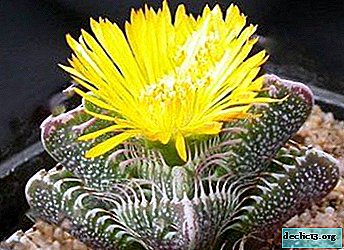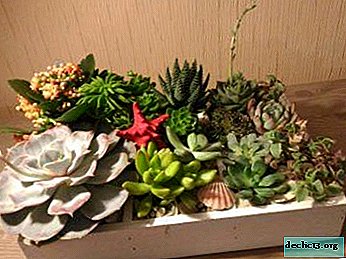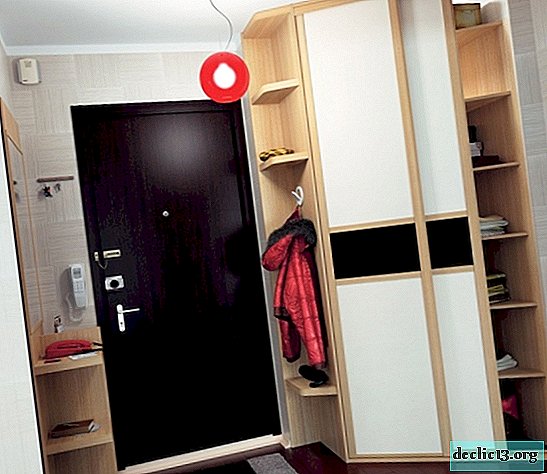What types of faucaria happens, how does this plant look in the photo, and what is known about growing a flower?

It is almost impossible to look away from blooming Faucaria. At the same time, the prickly leaves of the plant resemble the open jaws of a predator, and the bright flowers strike with tenderness.
This small plant native to South Africa has adapted perfectly to the difficult conditions of survival. Therefore, care for faucaria will not cause any difficulties even for beginner growers.
Next, you will find out what this succulent is, how tiger faucaria, Bosch looks in the photo, and also learn about the names of other species. You can also watch a useful video on this topic.
Botanical characteristic
Attention: Faucaria is a perennial succulent from the Aizov family. For the shape of the leaves, Faucaria was popularly called a wolf, tiger or cat's mouth.This genus of succulents has 33 species and 4 varieties. The maximum height of the succulent reaches 10 cm. On the surface of the pot dense rosettes of fleshy leaves are formed. The foliage is located crosswise. The plant rarely blooms, but if this happens, then the flowers are single, small, up to 3.5 cm in diameter. Their color is white or yellow with a golden sheen, depending on the type of succulent.
Faucaria inhabits the driest regions of South-West Africa, in the Cape. The annual precipitation there is only 200-300 mm, and the average daily air temperature in summer exceeds + 50ºС.
Description of popular Faucaria species with names and photos
Tiger (Tigrina)

One of the most common types of Faucaria for home maintenance. Faucaria tigrina has a thick stem up to 5 cm high. The leaves of the plant completely hide the shoot and have many bright short teeth along the edges. When flowering, one sandy yellow flower is formed, 5 cm in diameter.
Bosch (Bosscheana)

Thick leaves of Faucaria bosscheana are up to 5 cm long. It is a small shrub with large yellow flowers 4-5 cm. The leaves are also covered with spikes and slightly concave inward.. This species of faucaria blooms in autumn.
Feline (Felina)

The largest variety of plants, reaching 10-15 cm in height. At the same time, the dark green leaves of the succulent are covered with thorns not only on the sides, but also in the center. By this, they resemble cat tongues, which earned their name. The flowers of the plant are sunny and fluffy, composed of needle petals.
Toothed (Paucidens)

The leaves of this plant are pale green in color up to 5 cm in length. The sheet plate is covered with dots of dark green color and is equipped with several cloves at the edges. Yellow succulent flowers do not reach more than 4 cm in diameter.
Lumpy or Warty (Tuberculosa)

Succulents of this species can reach 8 cm in height, but at the same time it has a branching stem. The leaves are dark green, serrated and fleshy fused to the base. The shape of the leaves is rhombic or triangular, with whitish blots on the surface. The flowers of the plant are also yellow.
We recommend watching a video about the features of flowering of Warty Faucaria:
Candida (Candida)

Outwardly, Candida faucaria is very similar to the tiger species. The only striking difference between this species and the rest is the presence of large snow-white flowers during flowering.
Wolf (Vulpina)

The plant has lanceolate leaves with three faces at the end. The surface of the leaves is rough, with a cartilaginous border. Along the edge of the leaves there are several pairs of hairy teeth bent back. Succulent blooms in yellow flowers in the middle of summer.
Home Care
- Temperature and light. The plant requires the hottest and most lighted place in the house. Ideally, if the succulent is placed on the south windowsill, without shelter from direct sunlight. Even if the air temperature reaches + 50ºС, it will not cause any negative consequences.
In winter, the plant should be moved to a cooler room with a temperature of 5-10 ° C above zero for the normal development and formation of flower buds. In winter, the plant may require additional lighting.
- Watering. Faucaria should be watered in moderation and in small portions.. Water should be distributed over the surface of the soil, avoiding contact with leaves. Water temperature should be slightly higher than room temperature and distant from chlorine. Important: Make sure that between watering the soil has time to dry out at least half. Bathing and spraying Faucaria is contraindicated. During the rest period, watering must be completely stopped.
- Priming. The composition of the soil for the plant must necessarily include river sand, leaf and turf soils in equal proportions. In this case, the soil should be loose and have excellent drainage at the bottom of the pot. You can buy ready-made soil for succulents.
- Top dressing. A small portion of the feed will benefit Faucaria. But do not get too carried away with this business. In April-October, once a month, the plant is watered with half the recommended portion of the diluted mineral complex for cacti.
 Transfer. Pruning faucaria is not required, but it needs to be transplanted every two years. If the plant is grown from seeds, then a transplant is needed annually. There is a transplant in the spring. For this purpose, wide and shallow pots are suitable, on the bottom of which a good layer of drainage is necessarily laid out. In order to avoid rotting of the roots, it is possible to water the succulent after transplantation only after two weeks.
Transfer. Pruning faucaria is not required, but it needs to be transplanted every two years. If the plant is grown from seeds, then a transplant is needed annually. There is a transplant in the spring. For this purpose, wide and shallow pots are suitable, on the bottom of which a good layer of drainage is necessarily laid out. In order to avoid rotting of the roots, it is possible to water the succulent after transplantation only after two weeks.- Wintering. During wintering, the air temperature for Faucaria should be reduced to + 10ºС. At the same time, watering during the wintering period must be completely stopped. Additional lighting may be required, but even without it, the succulents will winter well in an apartment.
Breeding
Side shoots
- Cut the shoot and dry it for 3-5 days, while the cut should be perpendicular to the stem.
- Dried shoots should be placed in wet sand and wait until they take root (3-4 weeks).
- The temperature should be maintained from 25 to 28ºС.
- Put down the roots of the child in permanent pots with prepared soil.
- The first watering is carried out 2-3 weeks after transplanting into pots.
Seeds
Propagation of faucaria by seeds is a more complicated and painstaking way.. Step-by-step scheme:
- seeds are sown in well-washed river sand without deepening, according to a 1x1 cm pattern;
- sowing is covered with glass and maintain temperature + 25ºС;
- it is necessary to moisten the substrate moderately, but regularly, avoiding overdrying and overflow;
- after the emergence of seedlings (5-9 days), seedlings should be dived into the ground from turf and sheet earth, sand and brick chips, in a ratio of 1: 1: 1: 0.5.
We recommend watching a video about growing Faucaria from seeds:
Outdoor cultivation
 Succulents need a lot of sun. Being planted in open ground in the shade, the plants are stretched, lose their color and wax coating, and then rot and die.
Succulents need a lot of sun. Being planted in open ground in the shade, the plants are stretched, lose their color and wax coating, and then rot and die.
In addition, plants of these species do not tolerate moisture stagnation. The soil for succulents should be sparse and fairly rough in composition, with a high sand content.
For breeding Faucaria in open ground, an alpine hill with a slight slope is suitable. Then after winter, when the snow melts, the water will not stagnate, but will immediately go to the ground.
Faucaria is not suitable for open ground. It is better to choose other types of succulents for the alpine hill, less heat-loving, and grow faucaria at home.
Bloom
With proper care, Faucaria blooms in the summer, June-July. Flowering continues for about two weeks. In this case, the flowers open in the morning and close in the evening. Faucaria blooms only in the bright sun, and in cloudy weather the flowers remain closed. From the central part of the outlet, 1-5 flowers bloom in yellow with a glossy surface.
Why doesn't buds open?
Most often, the problems of flowering succulents are caused by errors in care. The main factors are a lack of light, a violation of the temperature regime or improper hydration. The main mistake of beginner gardeners is to water abundantly during wintering. Give the plant a lot of light and it will annually delight with its sunny flowers.
Diseases and Pests
- Root rot, fusarium and late blight - to combat the disease, the plant and the soil are treated with a solution of potassium permanganate with boric acid.
- Spider mite, mealy or root mealybug - to control pests, wipe the leaves with a brush dipped in an insecticide or rinse the roots in an insecticide solution, replanting afterwards into a new dry soil.
Similar Succulents
There are several succulents very reminiscent of their appearance as a Faucaria.
 Haworthia - a small rosette succulent from South Africa. This is a hard-leaved or herbaceous plant with green leaves having cilia along the edges of the leaf plate;
Haworthia - a small rosette succulent from South Africa. This is a hard-leaved or herbaceous plant with green leaves having cilia along the edges of the leaf plate;- Young - a beautiful succulent from Southwest Asia, with a natural symmetry of the arrangement of leaves. The plant is perfect for planting spectacular compositions from different species of this succulent.
- Echeveria - "stone rose" from Central America. Succulent with a short stem or no stem at all. The plant has dense rosettes of leaves at the ends of the shoots.
- Appenia - Succulent from South America with a fleshy stalk and oppositely located heart-shaped leaves. At the ends of the lateral shoots in the leaf sinuses of the aptenia, there are small red flowers.
- Argyroderma - evergreen succulent from Africa and the desert of Peru. By its appearance, the plant resembles sea pebbles collected in small groups. The leaf rosette consists of 2-4 fleshy greenish-gray leaflets of a semicircular shape, half fused together.
Conclusion
Despite the fact that faucaria is an extremely light-loving and heat-loving plant, this flower adapts well to the conditions of detention in the apartment. The plant does not require special care and is suitable for all flower growers who do not even have experience in growing succulents of other species.

 Transfer. Pruning faucaria is not required, but it needs to be transplanted every two years. If the plant is grown from seeds, then a transplant is needed annually. There is a transplant in the spring. For this purpose, wide and shallow pots are suitable, on the bottom of which a good layer of drainage is necessarily laid out. In order to avoid rotting of the roots, it is possible to water the succulent after transplantation only after two weeks.
Transfer. Pruning faucaria is not required, but it needs to be transplanted every two years. If the plant is grown from seeds, then a transplant is needed annually. There is a transplant in the spring. For this purpose, wide and shallow pots are suitable, on the bottom of which a good layer of drainage is necessarily laid out. In order to avoid rotting of the roots, it is possible to water the succulent after transplantation only after two weeks. Haworthia - a small rosette succulent from South Africa. This is a hard-leaved or herbaceous plant with green leaves having cilia along the edges of the leaf plate;
Haworthia - a small rosette succulent from South Africa. This is a hard-leaved or herbaceous plant with green leaves having cilia along the edges of the leaf plate;














